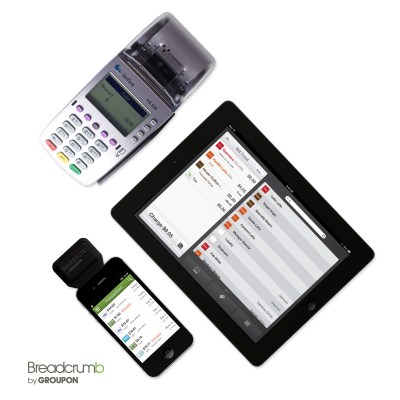Groupon — one of the many players out there along with Square, PayPal’s Here and others looking to get a piece of the action in payments services among local merchants — is kicking off a new expansion for its Breadcrumb mobile payment service that it hopes will bring yet more businesses on to its platform: it’s announcing integrations with Verifone and Ingenico, two of the biggest producers of payment terminals used at the point of sale, so that merchants can use these to process card payments instead of dongles attached to their iOS or Android smartphones and tablets.
As with all of Groupon’s other mobile payments services, this is going live only in the U.S. for now.
The move is a somewhat significant departure, but also a coming of full circle, in the mobile payments space. In the past, companies like Verifone have positively butted heads with the likes of Square, accusing it of being an insecure alternative, before subsequently (and unsuccessfully) trying to compete with like-for-like services.
In the meantime, companies like Groupon, Square and rest have positioned themselves as disruptors in the space, giving merchants — many of whom may never been able to take card payments before — the ability to do so, with fees far lower than those traditionally charged by banks.
This — Groupon’s first integration with credit card terminals — is something of a halfway meeting. Merchants can still use Groupon’s iOS or Android apps as a dashboard and way of acting like a virtual cash register. But when it comes to physically taking the card, now they can do it via one of these terminals. This can be a device they already own, one that they buy from Groupon for $150, or rent for $15 per month. They can also continue to use dongles for some payments in their network, if they choose.
Sean Harper, director of product, Groupon, tells me that the idea here is to cater not to those merchants who have never taken payments by card before — this is the group that many of the Square-style mobile payments services got their start targeting initially — but the possibly harder-to-reach group: those who have and have yet to jump into using more modern, linked up services, such as those that Groupon offers to provide transaction analytics, loyalty services and the ability to redeem Groupon discount offers as part of the package.
The attractor here is not embracing (and paying) for new technology but getting those users on board with the promise of lower fees using the same stuff they’d always used. (Groupon’s fees start at 1.8% plus $0.15 per transaction on MasterCard, Visa and Discover; a higher sliding scale on AmEx. It offers a free app for all local merchants, and a paid “Pro” app with more features specifically for those in the restaurant business.)
“The reality is that it is very hard to change merchant behavior,” says Harper. “In order to be successful, we have to use products that they use. For some the dongle is the best solution — for example if you are driving around or selling in a farmers market, a mobile phone is awesome. And if you are making an investment and buying an iPad it’s a more advanced piece of software, a super platform. But there are a lot of merchants have practical considerations where they do not need these things.”
He points out Groupon did not go into this without on-the-ground research. He says some merchants said they didn’t want to use iPhones for payments because they worried about theft or ease of use: “the traditional terminal is heavy and sits in one place, they can swipe with one hand and make a sandwich with the other.” The other key thing is that a terminal is cheap. “a couple of hundred dollars whereas a full iPad set up can easily cost $1,000.”
This is not Groupon’s turn away from investing in more new technology. “We’re heavily invested in that area,” Harper emphasizes. “It’s more that we’re trying to provide a gateway drug for those who are not early adopters to start using our services.”
And really, if you look at how much Square has evolved over the last year to include business directories, merchant dashboards and more, it’s clear that transactions is just part of the equation in mobile payments. For Groupon, the real bread and butter is the cut that the company gets on offering actual Groupons, the local deals. The more services — be they traditional payment terminal card transactions or fancy location-based push notifications on consumers’ iPhones of things they are more likely to buy — that Groupon can create to drive stickiness to its platform, the more successful it will be in the longer term.
